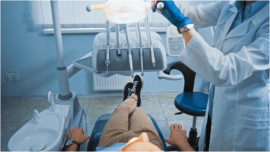
July 14, 2023, 10:10 am
The field of dentistry is continually evolving, driven by advancements in technology, research breakthroughs, and changing patient expectations. Staying updated on emerging trends and innovations is crucial for dental professionals to provide the highest level of care and remain competitive in a dynamic industry.
-
Digital Dentistry: Digital dentistry has revolutionized various aspects of dental practice, from diagnosis and treatment planning to restoration fabrication. Advanced technologies, such as cone beam computed tomography (CBCT), intraoral scanners, and computer-aided design/computer-aided manufacturing (CAD/CAM) systems, have transformed traditional workflows. Dental professionals can now capture highly accurate digital impressions, design restorations digitally, and fabricate them with precision using chairside milling or 3D printing. Embracing digital dentistry streamlines workflows, enhances accuracy, and improves patient outcomes.
-
Minimally Invasive Dentistry: The trend towards minimally invasive dentistry aims to preserve natural tooth structure and minimize patient discomfort. Advances in adhesive materials, biomimetic restorative techniques, and preventive strategies have shifted the focus towards early intervention and conservative treatment approaches. Dental professionals are increasingly adopting minimally invasive procedures, such as air abrasion, laser dentistry, and caries detection devices, to provide targeted treatment while preserving healthy tooth structure. This approach improves patient experience, promotes faster recovery, and maintains long-term oral health.
-
Cosmetic Dentistry Advancements: Advancements in cosmetic dentistry have opened up new possibilities for enhancing smiles and boosting patient confidence. Dental professionals now have access to a wide range of aesthetic treatment options, including tooth-colored restorations, ceramic veneers, clear aligners, and teeth whitening systems. Digital smile design tools and simulation software enable precise treatment planning and visualization of anticipated outcomes. The integration of cosmetic dentistry with digital workflows allows for predictable and personalized treatment, meeting the growing demand for aesthetic improvements.
-
Implant Dentistry Innovations: Implant dentistry has witnessed significant advancements in recent years, offering improved treatment outcomes and patient satisfaction. Innovations in implant design, surface technology, and guided implant placement techniques have enhanced predictability and reduced treatment timelines. The integration of digital implant planning and navigation systems allows for precise implant placement, optimizing esthetics and function. Additionally, developments in bone grafting materials and techniques have expanded treatment options for patients with compromised bone structure, enabling more successful implant placements.
-
Teledentistry and Remote Patient Monitoring: The rise of telehealth has extended to dentistry through teledentistry and remote patient monitoring. These technologies enable dental professionals to provide consultations, perform evaluations, and monitor oral health remotely. Patients can seek advice, receive treatment recommendations, and access preventive education from the convenience of their homes. Teledentistry has proven particularly beneficial for underserved populations, rural areas, and patients with limited mobility. Dental professionals can leverage these technologies to expand their reach, improve access to care, and enhance patient engagement.
-
Laser Dentistry: Laser technology has gained traction in various dental procedures, offering numerous benefits over traditional techniques. Lasers provide precise and minimally invasive soft tissue procedures, such as gum contouring, frenectomies, and periodontal treatments. They can also be used for cavity preparation, eliminating the need for anesthesia and reducing patient discomfort. Laser dentistry offers improved healing, reduced bleeding, and enhanced postoperative recovery, making it an attractive option for both patients and dental professionals.
-
AI-Assisted Dentistry: Artificial intelligence (AI) has made inroads into dentistry, offering exciting possibilities for diagnostics, treatment planning, and patient care. AI algorithms can analyze radiographic images, intraoral scans, and patient data to aid in the detection of oral diseases, such as caries and periodontal conditions. AI-powered software can assist in treatment planning by providing insights and recommendations based on large datasets and evidence-based guidelines. Additionally, AI chatbots and virtual assistants can enhance patient communication and support, providing timely responses to inquiries and delivering personalized oral health information.
-
Biocompatible Materials and Biomimetic Dentistry: The development of biocompatible materials and biomimetic approaches in dentistry aims to mimic the natural properties of teeth and tissues, enhancing treatment outcomes and longevity. Biomimetic restorations focus on preserving tooth structure and bonding restorations to tooth surfaces, promoting long-term strength and esthetics. Dental materials, such as bioactive cements and tooth-colored composites, mimic the natural properties of teeth, improving biocompatibility and reducing sensitivity. These advancements contribute to more conservative and durable restorations.
-
3D Printing: The emergence of 3D printing technology has transformed the manufacturing of dental models, surgical guides, and prosthetics. Dental professionals can now digitally design and fabricate custom dental appliances, including crowns, bridges, and dentures, using biocompatible materials. This technology offers greater accuracy, faster turnaround times, and cost-effective solutions for both dental professionals and patients. 3D printing has the potential to revolutionize dental laboratories and improve treatment outcomes through precise and personalized restorations.
-
Holistic and Integrative Dentistry: The holistic approach to dentistry focuses on the overall well-being of the patient, recognizing the interconnectedness of oral health with general health. Integrative dentistry combines traditional dental practices with complementary therapies and wellness approaches. Dental professionals embracing this trend consider not only the oral health of their patients but also their lifestyle, nutrition, and systemic health. This patient-centered approach promotes a comprehensive and personalized approach to oral care, contributing to improved overall health outcomes.
Keeping on top of emerging trends and innovations is crucial for dental professionals to provide high-quality care and remain competitive in a dynamic industry. Embracing digital dentistry, minimally invasive approaches, and cosmetic dentistry advancements allows for enhanced treatment outcomes and patient satisfaction. Integrating teledentistry, AI-assisted dentistry, and laser technology expands access to care and improves treatment precision. Utilizing biocompatible materials, 3D printing, and adopting holistic approaches fosters personalized and comprehensive oral health care. By staying ahead and embracing these emerging trends, dental professionals can offer cutting-edge treatments, deliver exceptional patient experiences, and contribute to the advancement of the dental field.
